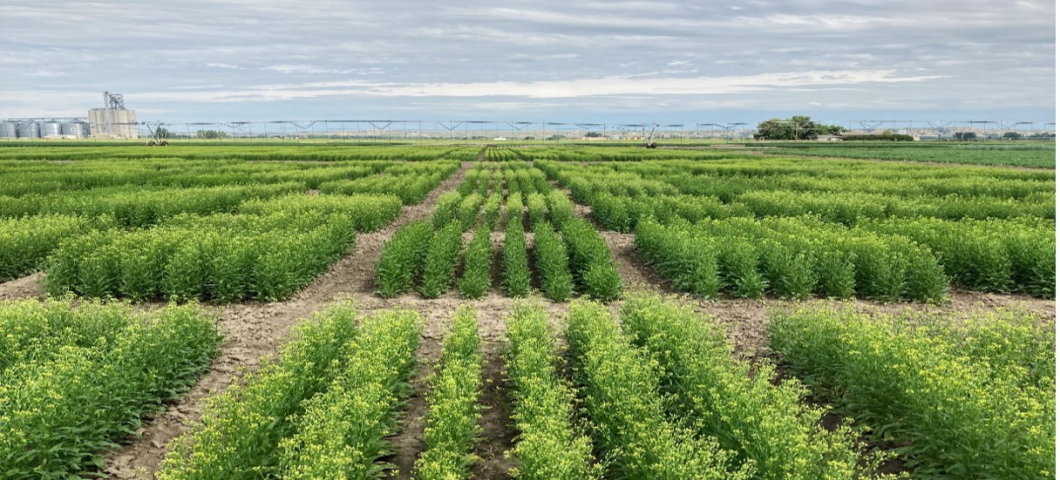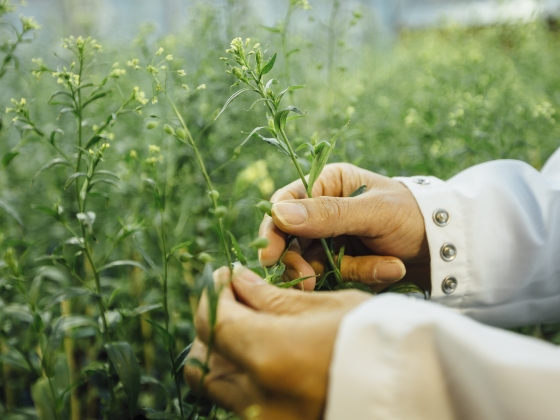Bozeman, Montana, USA
July 7, 2025
 Test plots of camelina at MSU's Eastern Ag Research Center. Image courtesy of Chengci Chen.
Test plots of camelina at MSU's Eastern Ag Research Center. Image courtesy of Chengci Chen.
Thanks to two unique licensing agreements, new camelina cultivars developed at Montana State University will have the opportunity to make maximum societal and commercial impact.
The MSU Technology Transfer Office, or TTO, licensed two MSU cultivars of camelina to independent companies in Montana and Connecticut. Camelina, which comes from the same plant family as mustard, broccoli and cabbage, is an oilseed plant that can be used for biofuels, cosmetics and livestock feed and supplements. MSU faculty member Chengci Chen, superintendent of the Eastern Agricultural Research Center in Sidney, and Chaofu Lu, a professor in the Department of Plant Sciences and Plant Pathology, have been conducting camelina research in Montana for more than two decades.
New plant breeds are owned by the university, said TTO director Daniel Juliano. For common crops such as wheat or barley, those new breeds are often released for use by farmers. But for a specialized crop like camelina, the breed is usually exclusively licensed to private companies, which can then manage the commercialization process, often contracting farmers to grow the crop.
In the case of the new camelina lines, the exclusive licenses were awarded to Sustainable Oils, which is headquartered in Great Falls, and Ash Creek Renewables, based in Connecticut. Sustainable Oils develops camelina-specific biofuels, while Ash Creek Renewables works with various products like soybean oil, animal fats and waste oils to create more sustainable fuel solutions. Camelina will be an addition to their repertoires of resources.
Lu and Chen have led MSU’s camelina research by focusing on cultivar development, genetic improvement and cropping systems to incorporate camelina into Montana’s agricultural production. Their recent projects aim to understand the variances in how different camelina lines take in and use nitrogen, using that knowledge to develop cultivars that can grow in low-nitrogen soil or drought conditions while maintaining high oil yield. Multi-year and multi-location field trials are necessary to test the plant’s adaptation to various environments and identify superior traits, said Chen.
“This exploration of camelina has been going on for a long time, and Montana was one of the first states to start looking into it for commercial production,” said Lu. “These traits are genetically inherited, which means we can identify which genes are influencing them and work to breed for those genes.”
 Chaofu Lu has conducted research on camelina at MSU for more than two decades. MSU Photo by Adrian Sanchez-Gonzalez
Chaofu Lu has conducted research on camelina at MSU for more than two decades. MSU Photo by Adrian Sanchez-Gonzalez
Lu’s research has been funded by the U.S. Department of Energy since 2016, and he is currently leading a multi-institution project blazing trails in camelina science. The work led to his being named a fellow of the American Association for the Advancement of Science last year.
The exploration and understanding of camelina genetic mechanisms constitute fundamental research that is a major part of MSU’s land-grant mission. But another part of that mission is societal benefit, said Juliano. Licensing MSU varieties to industry partners creates a bridge between the science and its applications. MSU has licensed wheat and barley varieties in the past, as well as crops such as triticale, oats, safflower and alfalfa.
“Some stuff is so fundamental, the societal impact is way, way downstream. But many things can have much more near-term societal impact, and this is one of them,” Juliano said. “These new camelina lines are most valuable if people can get access to them, so by licensing them to companies that can then invest in commercializing them, those companies can then deliver products and services to the rest of society.”
Agreements such as those with Sustainable Oils and Ash Creek Renewables mean that while MSU still owns the lines, the companies have exclusive rights to commercialize them and develop new products with them. The profits from those benefit both industry and the university, since a percentage of royalties return to the plant breeding programs housed in the MSU College of Agriculture to ensure their continued ability to conduct emerging research.
When public research and private partnerships like this are developed through technology transfer, it also serves to foster conversations and extend the MSU’s reach in the crop production and manufacturing industries, Juliano said. Just as businesses and community partners rely upon the university to generate knowledge, being in contact with the people who will use and benefit from that knowledge helps scientists to tailor their inquiries, ensuring the focus remains on the questions that end users find most important.
This can have a particular impact on graduate students, he noted, many of whom may end up pursuing careers in industry. Building those relationships while still in school can lead to new research ideas, future job opportunities and a more efficient flow of knowledge.
“I think it's a very healthy facet of all these activities that graduate students and faculty are having this contact with industry, getting to work on industry problems,” Juliano said. It really helps them stay well-grounded in their research.”